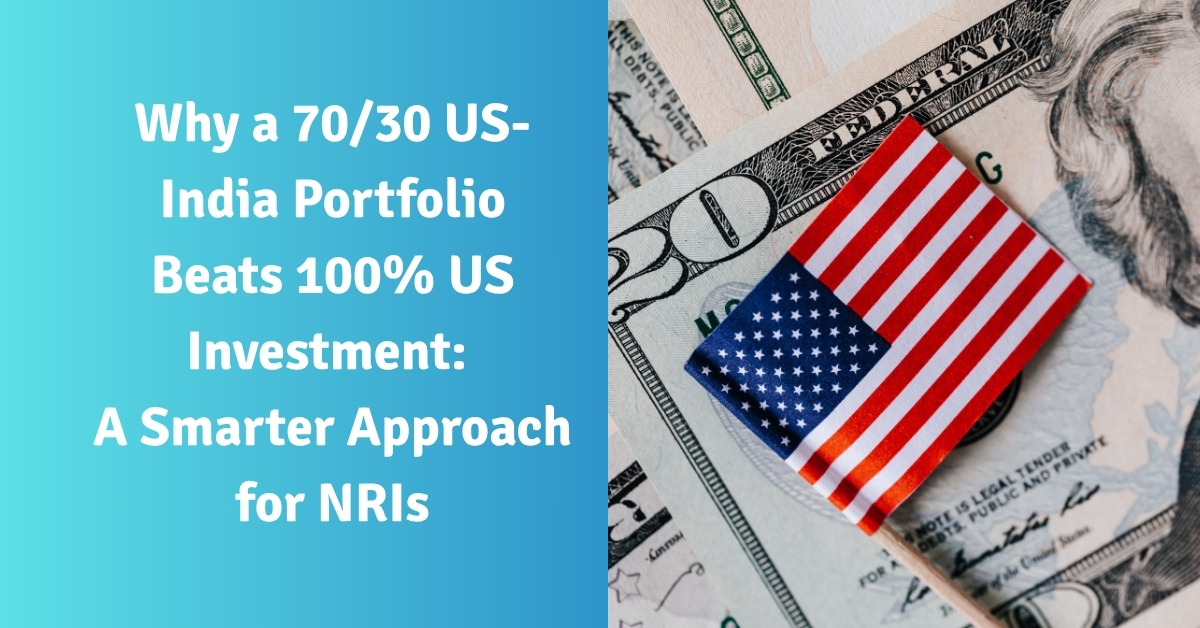Why a 70/30 US-India Portfolio Beats 100% US Investment: A Smarter Approach for NRIs

For NRIs accumulating wealth transnationally, the most prevalent investment path is to invest entirely in US-based assets. This may be conservative and comfortable-sounding, but a 100% US portfolio might not prove to be the most lucrative over the long term. Recent study and past performance indicate that a diversified 70/30 approach investing 70% in US markets and 30% in Indian markets is not only more lucrative, but less volatile.
The results are empirical. They’re based on 15 years of backtested data, showing a steady edge for the diversified strategy. This strategy is all the more applicable to NRIs, as they’re financially connected to both nations.
Outperformance Backed by Data
Over a span of 15 years, the 70/30 US-India portfolio provided a 2.3% higher average return per year over a 100% US portfolio. The differential, compounded over time, is significant. An example: $100,000 invested in an all-US portfolio would have amassed to approximately $325,000. The same in a 70/30 portfolio? Roughly $403,000-$78,000 more.
What makes it even more attractive is the lower portfolio volatility. The 70/30 approach yielded some 12% less volatility. Fewer wild market swings and a more comfortable investment ride in general. For NRIs looking to save for long-term objectives such as retirement, this stability can be as useful as higher returns.
The Three Pillars of the 70/30 Advantage
What is it about this combination that works? Three main forces are at play.
First, the US and Indian economies often move on different cycles. When one dips, the other may rise, providing a natural counterbalance. This non-correlation smooths returns over time.
Second, currency diversification becomes a built-in benefit. With earnings and liabilities potentially in both USD and INR, having investments in both currencies helps hedge against unfavorable currency fluctuations.
Third, the Indian growth narrative cannot be ignored. Set to become the third-largest economy in the world, India’s youth demographic, digitalization at lightning speed, and investment in infrastructure render it a sure bet for long-term growth. A 30% interest in Indian markets is akin to buying a seat on a high-speed train.
Creating the 70/30 Portfolio
This strategy is simpler to implement than it might seem. For the US portion, broad-based index funds or ETFs like S&P 500 or total market indexes prove convenient. Mixing in some mid-cap and small-cap funds can further diversify.
For the Indian investment, NRE or NRO accounts can invest directly in Indian mutual funds on behalf of NRIs. Or, India-specific ETFs listed in US exchanges provide a convenient route without the necessity to open Indian brokerage accounts. Some of these consist of ETFs that replicate indexes such as the Nifty 50 or Sensex, or high-growth sector-focused funds.
Regular rebalancing keeps the proportion in check with investment targets. A regular annual check would suffice to remain on course.
Issues NRIs Frequently Mention
Some concerns typically arise on this strategy. One is market volatility in India. But considering only 30% is there, the influence is cushioned by the other 70% in relatively safer US assets. In fact, the combination creates improved risk-adjusted returns.
Currency risk is a common concern. Yet, for NRIs with financial obligations in both nations, currency diversification is less of a menace and more of a cushioning. It makes the portfolio responsive to actual-world financial obligations.
Today’s volatile global environment makes diversification a reality, not an option. A diversified portfolio will not over-expose investors to any one economy or currency.
Why It Matters More Than Ever
70/30 isn’t about ratios. It is indicative of the split personality and fiscal footprint of NRIs. The approach marries the security of the mature US market with the dynamic growth possibilities of India’s growing economy.
Transitioning to 70/30 doesn’t have to be drastic. Phase the changes by incorporating new investments or shifting over the course of a period. Planning ahead by looking at current portfolios, establishing long-term objectives, and consulting the advice of those with cross-border experience will save time and provide peace of mind.
Conclusion
The 70/30 US-India investment strategy is not only data-driven it’s also deeply aligned with the financial realities of NRIs. It offers higher returns, lower volatility, and greater currency resilience. More importantly, it creates a portfolio that mirrors the global lives NRIs lead.
Investing isn’t just where the markets are right now. It’s where the opportunities will be in the future. And with India’s growth only increasing, the 70/30 tactic keeps NRIs from standing on the sidelines they’re on the ride.
FAQs
1. What does a 70/30 US-India portfolio mean?
Ans- It means allocating 70% of investments in US-based assets and 30% in Indian markets.
2. Why is the 70/30 mix considered better than 100% US?
Ans- Historical data shows it offers higher returns with lower volatility, making it a smarter long-term strategy.
3. Is this strategy suitable for retirement planning?
Ans- Yes. The combination of stability and growth makes it ideal for building a retirement corpus.
4. How does this strategy manage currency risk?
Ans- Investing in both USD and INR creates a natural hedge, especially useful for NRIs with financial ties to both countries.
5. Can this strategy be implemented gradually?
Ans- Yes. It can be phased in by directing new investments toward Indian assets over time.
6. Are there tax implications for NRIs investing in India?
Ans- Yes, but many NRIs benefit from tax treaties like the DTAA. Consulting a tax advisor is recommended.
7. What are the best US instruments for the 70% portion?
Ans- Broad-based index funds or ETFs, like those tracking the S&P 500 or total US market, are ideal.
8. How can NRIs invest in Indian markets without an Indian brokerage account?
Ans- India-focused ETFs listed on US exchanges offer exposure without needing an Indian account.
9. How often should the portfolio be rebalanced?
Ans- A yearly review is usually sufficient to maintain the 70/30 ratio.
10. Is this strategy valid during economic downturns?
Ans- Yes. Diversification helps manage risk better during volatile economic conditions.
Disclaimer: The information provided here is for educational and informational purposes only and should not be construed as financial, legal, or tax advice. Consult with a qualified professional before making any investment decisions. We do not accept any liability for errors or omissions in this information nor any direct, indirect, or consequential losses arising from its use.



